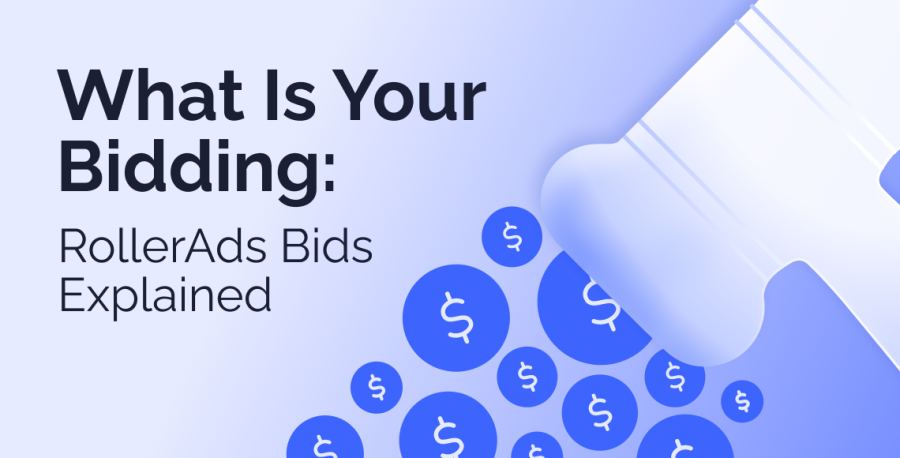Every affiliate marketer deals with an ad auction, but do you know how it works? Sure, you place a bid and your ad hopefully gets served, but do you know what happens under the hood?
In this article, we’ll go through the nuts and bolts of ad auctions: how they work, what sets RollerAds’ one apart, and what are the best practices. Place your bids, ladies and gentlemen.
A History Lesson
Advertising started in Ancient Egypt and China; it is as old as commerce (not to be confused with eCommerce 😂). Historical inventions like papyrus, the printing press, the radio, and TV modified advertising slightly, but the ads remained engraved on something tangible.
However, the internet revolutionized the field of advertising. When migrating online, webmasters realized they needed to make money on their websites somehow. That’s why they copy-pasted printed advertising and applied it to the digital world.
Publishers would negotiate the deal with the advertisers directly, engaging in direct selling. However, selling the ad spots directly leads to unsold inventory and inefficient monetization. The need for a mediator, capable of selling out ad spots in bulk and down-selling leftovers emerged.
Speaking of efficient monetization, register with RollerAds today and maximize your monetization output with our 5+ years of expertise in Push notifications and OnClicks — some of the best ad formats in the market.
Ad Network and Ad Auctions
Ad network serves as a bridge between publishers and advertisers. Moreover, an ad network helps to redistribute the unsold ad inventory, helping the publishers to sell out their spots and advertisers to buy at a discounted price.
Ad networks aggregate numerous publishers and host auctions for advertisers to bid on ad spots. Advertisers can establish campaigns through an ad network’s management panel or utilize third-party ad server pixels for verification and reporting across various networks and publisher deals. They define campaign parameters, and publishers integrate ad tags into their sites either directly or via a first-party ad server. Advertisers can rotate banners on websites via the ad network’s dashboard, eliminating the need to communicate with publishers.
Nuts and Bolts of Auction
Whether an ad will be served depends on the maximum bid value the advertiser is willing to pay, as well as the ad’s relevance to the final audience — but that’s just the tip of the iceberg. Here’s a more in-depth look at how the auction works:
- An advertiser sets up a PPC ad campaign. This includes choosing relevant ad placements (or keywords), setting up the highest bid they’re willing to pay, and making ad creatives.
- Users engage with content. Whether through visits to websites featuring ad placements or requests made to search engines, the platform triggers an ad auction.
- Eligible ads are picked for the auction. Ads aligned with the user’s search query or the website’s context compete for the ad spot. The highest bidder doesn’t always win the auction, since the ad content is also to be relevant
- Ads are ranked based on several criteria. Factors such as bid amount, CTR rate, ad extensions, phone numbers, and platform-specific variables influence ad rank.
- Winners emerge. The ad with the highest overall score, considering the aforementioned factors, usually secures the top spot. Subsequent ads follow in descending order. The actual cost per click (CPC) is determined by the auction.
- Ads are displayed and payments are made. Winning ads appear on the search engine results page (SERP), website, or social media platform. Advertisers are charged the agreed-upon CPC when a user clicks on their ad, unless…
A Word About SmartCPC and SmartCPM Bid Models
Different bidding models, such as CPC, CPM, SmartCPC, and SmartCPM, offer various ways to manage ad spending. While CPC and CPM are straightforward, smart bidding deserves attention.
Smart bidding adjusts bids dynamically, ensuring fair prices for clicks (SmartCPC) or impressions (SmartCPM) based on your chosen strategy. The default setting, ‘Average auction price,’ automatically adjusts bids for each ad placement according to its average price.
For instance, if zone 123456’s average bid is $0.05 CPC, you pay $0.05 per click from that zone. If the average bid drops to $0.03 the next day, your cost per click also decreases to $0.03. You can customize bid behavior using the ‘Bidding strategy’ slider, adjusting bids to follow the top or bottom bid for each placement.
Though you can trust the algorithm to handle bidding within your strategy, you can set limitations if desired. Under ‘Limits & Max Bid,’ you can set buying limits for each zone and establish a maximum CPC range. For example, if you set the Max CPC to $0.03, your actual CPC won’t exceed $0.03, even if the average bid is higher.
The SmartCPM operates similarly but considers the cost per 1,000 impressions instead of averages.
Common Bidding Problems and Remedies
All the stages happen in less than a second, which is why ad auctions require a powerful computational infrastructure to function as intended. However, blitz-like speed cannot outpace some problems, which ad auctions suffer from. RollerAds to the rescue!
“My campaign doesn’t get any ad impressions!”
Try increasing your bid size. It helps not only to get more traffic volume but also to win over first impressions with ads, leading to more leads of quality. They say you gotta spend money to make more money.
“My ads don’t get any clicks”
Check out our Creatives Library — a collection of converting creatives, optimized daily by CTR. You don’t have to copy-paste the most successful creatives. Consider using our library as a source of inspiration and guidance to enter a new vertical. For more information on Creatives Library, check out our dedicated article.
“I keep on wasting my ad budget”
Consider specifying frequency capping, the optimal ratio is 1 impression/ 24 hours, but there might be exceptions — contact our support for more details. Also, think about blacklisting underperforming zones and feeds, but only after Running On Network (RON) for a while. GEO targeting goes beyond just zones but includes also daytime capping — you don’t want to run campaigns when average people go to bed.
“Ad blockers mess up with ads”
Diversify ad formats. Ad blockers might work against OnClicks by blocking them, but our Push notifications bypass ad blockers. Also, ad format performance depends on the platform you opt for to generate traffic.
RollerAds prioritize the comfort of its partners, ensuring both publishers and advertisers enjoy fair and sustainable revenue generation. Register on our platform today and enjoy a profit, enhanced by Premium traffic, CPA optimization, Smart models, and other features.
“I don’t know where to start”
If you struggle to input your desirable targeting settings, consider using our presets. They are sets of traffic sources, optimized for a certain vertical. Unlike whitelabels, top sources are picked automatically, based on the performance of similar campaigns.
“I don’t know where to start, but prefer my own settings”
If you like to take the matter into your own hands, then visit our Rates tab after logging into your dashboard. There you will find all the information about current bids per GEO. This should guide you toward how much you’ll have to spend before making a profit.
Conclusion
Mastering the mechanics of ad auctions helps affiliate marketers to control their campaigns’ performance. Ad networks serve as crucial mediators between publishers and advertisers, facilitating efficient distribution of ad inventory.
Understanding the auction process reveals a nuanced system where bids, relevance, and bidding models like CPC and CPM determine outcomes. RollerAds, with its innovative features such as SmartCPC, SmartCPM, and diverse ad formats, provides effective solutions to common challenges like low impressions and ad blockers.
As a dependable partner, RollerAds prioritizes fair revenue generation for both publishers and advertisers. With features like Premium traffic and user-friendly presets, RollerAds offers a comprehensive solution for success in online advertising. Register now and try out all the features firsthand!





